Techniques of Kilim
In flatweaving there are a number of different types of loom (Picture #1, Picture #2) and weaving techniques but for purposes herein, the various types can be catogorized into two general groups. The first grouping contains the basic flatweave technique or "kilim weaving" (Picture #3). In a kilim, the pattern is formed by passing a yarn of a particular colour over and over and under the vertical yarns (known as warps) for the duration of the particular colour or design motif, then the same horizontal yarn (known as weft) is turned on the same path (next row) along the edge of the same coloured motif. This process is contnued until the individual motif is completed. Then the next motif is started where the initial one finishes, but the two yarn colours are not normally joined together in anyway, thus causing a slit to appear between the two respective yarns. Each block of colour is then woven succesively until the whole kilim is completed. When you hold a kilim woven in this way up to the light, you can easily see the slits where two patterns meet but do not join. The second grouping contains flatweaves which employ the technique of way wrapping or brocading.
0A motif is created by adding a third yarn to the warp and weft yarns which is wrapped arround the warp yarns in several configirations depent upon whether the intent is to weave Cicim (Picture #4), Zili (Picture #5), or Sumak (Picture #6).

(Picture #1) Loom

(Picture #2) Loom

(Picture #3) Kilim

(Picture #4) Cicim

(Picture #5) Zili

(Picture #6) Sumak
Three are two principal types of knots that are used in rug weaving. The first one is called double knot, Turkish knot, or Gordes knot (Picture #7) and naturally given a firmer weave yielding to a stronger and more durable carpet. The second one is known as the single knot, Persian knot, or Sennah knot (Picture #8).
The Turkish knot is standart of yarn encirling two warp threads, with the loose ends rawn tightly between the two warps. The Persian knot is a strand of yarn that encircles one warp threads and winds loosely around the other warp. One loose end pulled through the two warps, while the other end goes to the outside of the paired warps.
Rugs and the various flatwaves are made from five basic materials; sheep wool, goat hair, cotton, floss silk, and silk. The quality of wool varies according to the climate, the breed of sheep, and the time of year of the shearing. Wool from sheep that live in warm and arid regions is normally dry and brittle, and since it breaks so easly, it ends up being short and feels lifeless. Good quality wool comes from helthy and well fed sheep found in cold regions or at high elevations with good grazing lands and lots of water. In the colder regions, sheep grow a full fleece to keep warm and their bodies store fat which then translates to a high lanolin content within the fiber which reaches lenghts of 10 cm and more. The wool so obtained feels silky smooth and yet springy. Wool from the higher elevations (cooler also) and from the spring shearing is considered to be the highest quality. Wool is hand-spun (Picture #9, Picture #10) by using primative utensils called kirmen (drop spindle) and by spinning wheels.

(Picture #7) Double knot, Turkish knot, or Gordes knot

(Picture #8) Single knot, Persian knot, or Sennah knot

(Picture #9) Hand - Spun

(Picture #10) Hand - Spun
Women usually spin the wool during idle moments and street while spinning. In hand - spun wool, the original lenght of the fiber stays the same through the spinning process - a fiber that measured 7 cm. before spinning. Will still measure the same after spinning. Wool can also industrially spun, but the hard twisting of the fibers by the spinning machines tends to break some of the fibers. Although the broken bits and shorter fibers can be made to adhere together through the use of oils during the spinning process, the fiber will have lost some of its strenght, which, in turn, will shorten the life spun of the rugs to be woven.
In rug and kilim weaving, cotton is used mostly for the warp threads, as well as for the wefts. Compaired to wool, cotton is generally considered to be a more residant fiber and it is less elastic. So, tighter knots can be tied on cotton warps as opposed to wool. If very tight knot are tied to a wool warp, the fiber will break much more frequantly than if the warps were of cotton. Consequentl, woolen pile rugs with high knoting density counts will normally have cotton warps, for example, in Hereke, Ladik, and Kayseri Bunyan carpets.

Construction Materials
Carpets and kilims since their beginning, were not created just for meeting man's physical needs but also for his psychological wishes. Religious beliefs and ritual life enrich and develop philosophical thoughts and the soul of man. This influences both the artist and his work in various ways. Just looking at the motifs and compositions in the carpets and kilims makes this evident. The meanings of the motives in Turkish carpet are different depending on the region. However, generally the motives symbolize religious beliefs, nobility, power and the other themes described below briefly. The language of carpets and kilims not only indicates the skill of the weaver but also transmits their messages.
MAJOR MOTIFS USED IN TURKISH CARPETS AND KILIMS
Amulet and Evil Eye
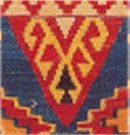 It is believed that some people possess a power in their glance which causes harm, injury, misfortune and even death. Evil eyes are various objects that reduce the effect of the evil glance, thus protecting the ones who carry them. "Muska" is a written charm which is believed to have magical and religious power to protect the possessor from dangerous external factors.
It is believed that some people possess a power in their glance which causes harm, injury, misfortune and even death. Evil eyes are various objects that reduce the effect of the evil glance, thus protecting the ones who carry them. "Muska" is a written charm which is believed to have magical and religious power to protect the possessor from dangerous external factors.
Bird
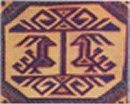 The bird motifs seen in Turkish carpets have various meanings. While birds live owls and ravens imply bad luck, doves, pigeons and nightingales are used to symbolize good luck. The bird is the symbol of happiness, joy and love. It stands for power and strenght. It is the imperial symbol of various states founded in Anatolia. The birds also refers to divine messengers and long life. The Anka bird (Phoenix) fighting with the dragon refers to spring.
The bird motifs seen in Turkish carpets have various meanings. While birds live owls and ravens imply bad luck, doves, pigeons and nightingales are used to symbolize good luck. The bird is the symbol of happiness, joy and love. It stands for power and strenght. It is the imperial symbol of various states founded in Anatolia. The birds also refers to divine messengers and long life. The Anka bird (Phoenix) fighting with the dragon refers to spring.
Burdock
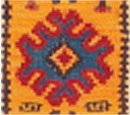 Burdock is a plant with burrs which stick to the clothing of people and the hair of animals. It is believed to be capable of warding off the evil eye. On the other hand, the fact that the term "like a burdock" means full of flowers, accounts for the use of this motif on flour bags as a symbol of abundance.
Burdock is a plant with burrs which stick to the clothing of people and the hair of animals. It is believed to be capable of warding off the evil eye. On the other hand, the fact that the term "like a burdock" means full of flowers, accounts for the use of this motif on flour bags as a symbol of abundance.
Chest
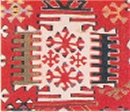 This motif in general, symbolizes the trousseau chest of a young girl. Since the objects in this chest is to be used in the husband's house, the expactations and hopes of the young girl are reflected in the pieces she has woven knitted and embroidered.
This motif in general, symbolizes the trousseau chest of a young girl. Since the objects in this chest is to be used in the husband's house, the expactations and hopes of the young girl are reflected in the pieces she has woven knitted and embroidered.
Cross and Hook
 In Turkish carpets hooks and various cross types are used frequently to protect from danger.
In Turkish carpets hooks and various cross types are used frequently to protect from danger.
Dragon
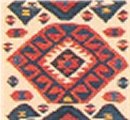
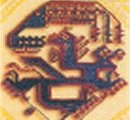 The Dragon is a mythological creature whose feet are like the lion's, whose tail is like a snake and who has wings. The dragon is the master of the air and water. The flight of the dragon and the Phoenix is believed to bring fertile rains of spring. The Dragon, believed to be a great serpent, is the guardion of treasures and secret objects as well as the tree of life.
The Dragon is a mythological creature whose feet are like the lion's, whose tail is like a snake and who has wings. The dragon is the master of the air and water. The flight of the dragon and the Phoenix is believed to bring fertile rains of spring. The Dragon, believed to be a great serpent, is the guardion of treasures and secret objects as well as the tree of life.
Eagle
 Eagle figures symbolizing such elements as power, might, amulets, government heraldry and charm originating from old religious traditions can be observed as totems in carpet-weaving.
Eagle figures symbolizing such elements as power, might, amulets, government heraldry and charm originating from old religious traditions can be observed as totems in carpet-weaving.
Earrings
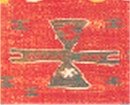 Earrings are indispensable as a wedding present in Anatolia. A girl using this motif is trying to inform her family that she wants to get married.
Earrings are indispensable as a wedding present in Anatolia. A girl using this motif is trying to inform her family that she wants to get married.
Eye
 It is believed that some people possess a power in their glance which causes harm, injury, misfortune and even death. The eye motifs were produced because of the belief that the human eye is the best protection against evil gazes.
It is believed that some people possess a power in their glance which causes harm, injury, misfortune and even death. The eye motifs were produced because of the belief that the human eye is the best protection against evil gazes.
Fertility
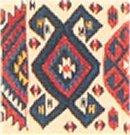 Hands on hips and ram's horn motifs used together denote a man and a woman. The fertility pattern is composed of two 'elibelinde' motifs indicating the female and two 'koçboynuzu' motifs indicating the male. The eye motif in the middle of composition is used to protect the family against the evil eye.
Hands on hips and ram's horn motifs used together denote a man and a woman. The fertility pattern is composed of two 'elibelinde' motifs indicating the female and two 'koçboynuzu' motifs indicating the male. The eye motif in the middle of composition is used to protect the family against the evil eye.
Fetter
 It symbolizes the continuity of the family union, the devotion of the lovers and the hope that should always stay together.
It symbolizes the continuity of the family union, the devotion of the lovers and the hope that should always stay together.
Hand, Finger, and Comb
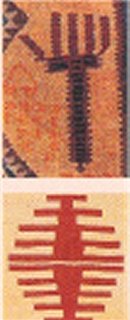 Hand, finger comb motifs including five points and five lines represents the belief that fingers are protection from the evil eye. Hand motifs combining productivity and good fortune also are a holy motive because it symbolizes the hand of the prophet Mohammed's sister. The comb motif is largely related with marriage and birth. It is used to express the desire for getting married and to protect birth and marriage against the evil eye.
Hand, finger comb motifs including five points and five lines represents the belief that fingers are protection from the evil eye. Hand motifs combining productivity and good fortune also are a holy motive because it symbolizes the hand of the prophet Mohammed's sister. The comb motif is largely related with marriage and birth. It is used to express the desire for getting married and to protect birth and marriage against the evil eye.
Hands on hips
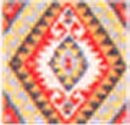 Hands on hips is the symbol of motherhood, femininity and fertility.
Hands on hips is the symbol of motherhood, femininity and fertility.
Hair Band
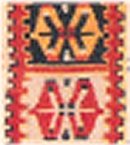 Hair Band motif indicates the desire to get married. If the woman uses some of her hair in weaving, she is trying to express her desire for immortality.
Hair Band motif indicates the desire to get married. If the woman uses some of her hair in weaving, she is trying to express her desire for immortality.
Ram's Horn
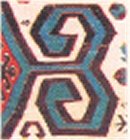 Ram's Horn represents productivity, heroism, power and masculinity in Turish carpets. Moreover it shows that the weaver is happy and it is the expression of this.
Ram's Horn represents productivity, heroism, power and masculinity in Turish carpets. Moreover it shows that the weaver is happy and it is the expression of this.
Running water
 Running water emphasizes the importance of water in human life.
Running water emphasizes the importance of water in human life.
Scorpion
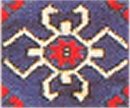 Due to their fear of its venom, people used to carry jewellery in the form of a scorpion or decorated with the tail of a scorpion in order to protect themselves against this animal. The scorpion motif is used for the same purpose.
Due to their fear of its venom, people used to carry jewellery in the form of a scorpion or decorated with the tail of a scorpion in order to protect themselves against this animal. The scorpion motif is used for the same purpose.
Star
 The star motif in Turkish carpets expresses productivity.
The star motif in Turkish carpets expresses productivity.
Tree of life
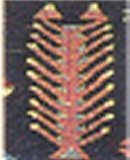 It is the symbol of eternity. The life tree represents the search for immortality and the hope of life after death.
It is the symbol of eternity. The life tree represents the search for immortality and the hope of life after death.
Wolf's mouth, wolf's track and monster's feet
 People use these motifs as a means of protection against wolves and monsters. Since ancient times men have believed that they could control and protect themselves from dangerous animals by imitating them or by creating a similar form.
People use these motifs as a means of protection against wolves and monsters. Since ancient times men have believed that they could control and protect themselves from dangerous animals by imitating them or by creating a similar form.
| There are two types of dyes which are used to dye wool for weaving: wegetable dyes and chemical dyes. Rugs and kilims which are made using natural dyes are the most preferred. The natural dyes are obtained from three sources: plants; animals; and minerals. Plant sources are used most widely in rug and kilim production. Some of the examples of colors obtained from plants and animal sources are: red (RUBIA TINTORIA); yellow (GENISTA TINTORIA); navy blue (ISOTIS TINTORIA and INDIGO FERETINTORIA); gray and black (OVER LUS); brown (JUNGLAND REGIA); and red (DACHYLOPIUS COCUS). Dyeing threads by using sources from nature is an art which has been practiced since ancient times. Anatolia has a large variety of plant available for dyeing purposes and this where the craft of dyeing has been improved through centuries of experience. | 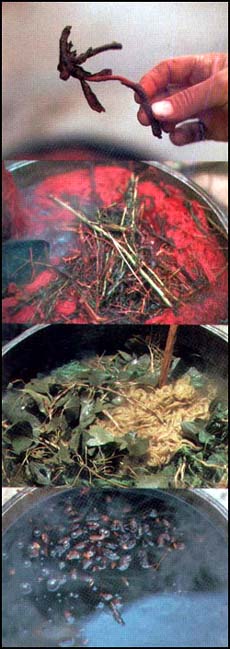 |
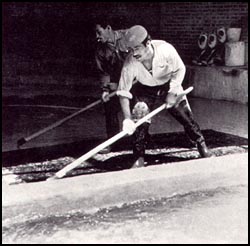 Looking after your rug from the beginning helps your rug last for a long time normal care consist of two steps.1. Periodic cleaning means removing the dust which has accumulated in the pile of the rug. The rug must be cleaned with a vacuum cleaner gently once a week and thoroughly once a month. This process prevents the settling of dust and crumbs within the pile.
Looking after your rug from the beginning helps your rug last for a long time normal care consist of two steps.1. Periodic cleaning means removing the dust which has accumulated in the pile of the rug. The rug must be cleaned with a vacuum cleaner gently once a week and thoroughly once a month. This process prevents the settling of dust and crumbs within the pile.
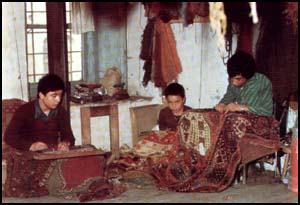 On new rugs, there can be some loose wool yarn. After a few times of vacuuming, the loose wool yarn will be removed. To clean spills and any sort of dirt on the rugs, the use-of soap and water is advised. A small amount of rug shampoo or ordinary soap many be poured into a container of cold water and the soiled area should be washed and wiped with a brush and cloth or sponge. Following this, the soap must be removed thoroughly with a clean cloth and left to dry. If water is absorbed completely and has passed to the under side of rug, then back the side of the rug must also be dried.2. The most suitable cleaning method is to have the rug washed completely by professional washers (not dry cleaners) once every 10 to 15 years. For further details, you can always write to us.
On new rugs, there can be some loose wool yarn. After a few times of vacuuming, the loose wool yarn will be removed. To clean spills and any sort of dirt on the rugs, the use-of soap and water is advised. A small amount of rug shampoo or ordinary soap many be poured into a container of cold water and the soiled area should be washed and wiped with a brush and cloth or sponge. Following this, the soap must be removed thoroughly with a clean cloth and left to dry. If water is absorbed completely and has passed to the under side of rug, then back the side of the rug must also be dried.2. The most suitable cleaning method is to have the rug washed completely by professional washers (not dry cleaners) once every 10 to 15 years. For further details, you can always write to us.

